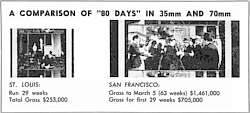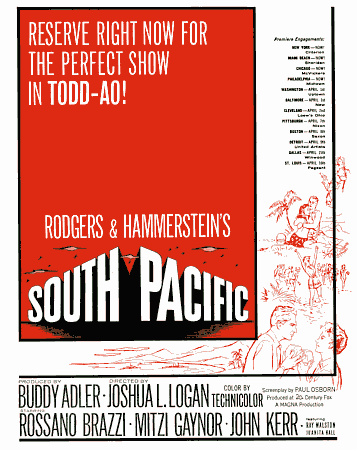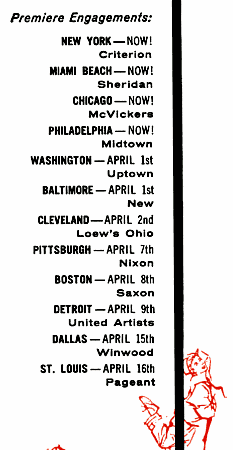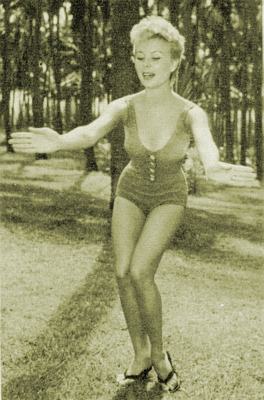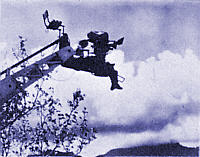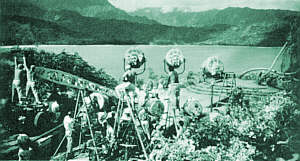|
|
|
|
|
|
|
|
|
|
|
|
70mm Film Finally Makes The Big Time
With two films having been run in 70mm roadshow presentations, just how much of a draw did Todd-AO have over 35mm? In an article from Motion Picture Herald we get a pretty good picture of how the two systems compared in their ability to draw audiences, and dollars.
At right: A theatre standee prepared to explain the workings of Todd-AO to theatre patrons. This version was prepared for display at showings of South Pacific in 1958. The camera and lens illustrated had been nearly obsoleted and replaced with Mitchell BFC and FC cameras with Todd-AO or Super Baltar lenses from Bausch & Lomb. This hand made display had been created for Oklahoma! at the Rivoli Theatre in New York, was updated for Around the World in 80 Days, and finally adapted for South Pacific.

"The Perfect Show in Todd-AO"
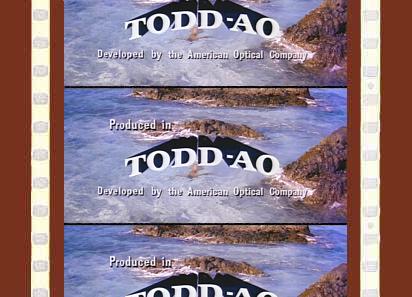
The third production in Todd-AO, returned to Rodgers & Hammerstein. This time the property was South Pacific, released in 1958. Mike Todd no longer held any portion of Todd-AO or its sponsoring organization Magna Theatre Corporation, of which Rodgers & Hammerstein were still directors. 20th Century-Fox, having abandoned its CinemaScope 55 process, now owned a significant share of Todd-AO. Company management made some technical decisions that really emasculated the system but made it far more economical to use. First of all, the film speed was dropped from the non-standard 30fps to standard 24fps, which made it possible to produce optical reduction prints in CinemaScope compatible anamorphic rather than filming each scene in two different processes. The deeply curved screen that had been used to emulate the participation effect of Cinerama was abandoned for a conventional flat screen. In order to show Todd-AO, theatres no longer had to undergo proscenium changes to install the curved screen. Now Todd-AO looked just like CinemaScope but with a sharper, more grain free image and higher quality stereophonic sound. With these changes in Todd-AO presentation, the use of the system's breathtaking 128 degree "bugeye" lens was almost entirely discontinued.
Magazine Ad Announcing Opening Dates For South Pacific ROADSHOW! Rather than open on 3,000 multiplex screens on the same day, the roadshow took things a bit more leisurely. Hopefully word of mouth would augment the advertising campaigns to make each theatre opening a bigger event than the last.
A frame enlargement described in the official program book as being Scene 51 Shoreline - Wide Angle Long Shot - (Bug Eye Lens) turns out not to be a bugeye shot afterall. Rather, it's a telephoto long shot, and one not used in the film.
South Pacific was not the critical success of the first two Todd-AO productions but it was actually a far better film than generally credited, featuring a more bitter-sweet storyline than typical of Rodgers & Hammerstein, and it dealt with social problems like bigotry, which was most unusual for the theatrical stage when it opened in 1949 and equally unusual for mainstream motion pictures in 1958. Now, over 40 years after its original release, South Pacific appears to be more popular than either of the two earlier Todd-AO films.
No doubt about it though, those color effects are pretty dumb, and grossly overdone, a problem that may have resulted from a misunderstanding between director Joshua Logan and the boys back at Fox's DeLuxe labs. Even with the emasculation of Todd-AO, the location photography in Hawaii and the production's Academy Award® winning sound were still stunning. And Mitzi Gaynor's figure made your eyes pop out.
A note from South Pacific director Joshua Logan to director of photography Leon Shamroy. Perhaps the heavy handedness of those color effects weren't totally the fault of the two fellows behind the camera.
Despite claims by a so-called "authority" that South Pacific was actually photographed in Super Panavision 70, you may rest assured that the Todd-AO credits are valid. 35mm anamorphic reduction prints distributed in the U.S. by DeLuxe labs credit Panavision for their MicroPanatar lens, though the wording of the title is rather cryptic. Seen at right is Leon Shamroy peering through the viewfinder
Seen at left is Mitzi Gaynor rehearsing a number for South Pacific. I include this photo simply because I like it. Miss Gaynor, as Nellie Forbush, and Ray Walston, as Luther Billis, (Oh those awful James Michener character names!), were the only two principal cast members who did their own singing in the film. Singing voices of the other principals, Rossano Brazzi, John Kerr, and even Juanita Hall were done by others. France Nuyen, at right as Liat, new to films at the time, neither spoke nor sang, but I put her picture here for the same reason as I did Mitzi's.
This photo provides a clue as to why the curator of the museum likes South Pacific and detests The Sound of Music. Can you figure out why? Hint: it has nothing whatsoever to do with Rossano Brazzi. The photo is the cover of the Australian souvenir booklet sold in theatres down under during the roadshow run.
















E-mail the author
CLICK HERE
©1996 - 2004 The American WideScreen Museum
http://www.widescreenmuseum.com
Martin Hart, Curator
